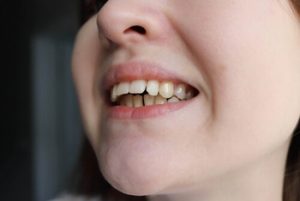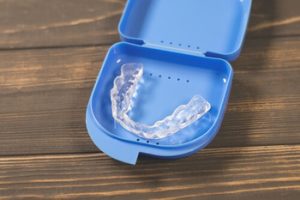An overbite, where the upper teeth excessively overlap the lower teeth, is more than a cosmetic issue. It can lead to jaw pain, tooth decay, as well as various oral health issues when not properly addressed. Fortunately, modern dentistry offers several safe and effective options for overbite correction, from traditional braces to jaw surgery, depending on the severity and cause. We’re here to help you understand these options, so continue reading this article to find the information you need. In this guide, we’ll explore the types of overbites, what causes them, and most importantly, how to fix overbite using various treatment methods. We’ll also address common questions about the treatment process and provide practical tips for maintaining a healthy, properly aligned bite.
What Is an Overbite?
A dental overbite refers to a condition where the upper front teeth significantly overlap the lower front teeth. This misalignment can affect chewing, speech, and even breathing in severe cases. Some degree of overbite is natural, but when it becomes excessive, it may require correction.
There are two primary types of overbites:
- Dental Overbite: Caused by tooth misalignment.
- Skeletal Overbite: Caused by the structure of the jaw bone.
Understanding the root cause is critical in developing an effective treatment plan. A dentist will evaluate whether you’re dealing with a minor overbite or more complex issues like deep bite, vertical overbite, or skeletal overbites.
Causes of Overbites
Overbites can stem from a variety of factors, both genetic and behavioural:
- Thumb sucking beyond early childhood
- Tongue thrusting, which pushes the front teeth forward
- Teeth grinding (bruxism)
- Prolonged dummy or bottle use in baby teeth
- Missing or crowded teeth
- Jaw development issues, especially if the upper jaw grows more than the lower jaw
In severe cases, the mismatch in the development of the upper and lower jaws contributes to skeletal overbite, necessitating more advanced intervention.
Why Fixing an Overbite Matters
While some people seek overbite correction for aesthetic reasons, untreated overbites can lead to several oral health problems, such as:
- Tooth decay from difficulty cleaning crowded teeth
- Gum disease due to plaque buildup
- Jaw pain or temporomandibular joint disorder (TMJ)
- Excessive wear on teeth from misaligned biting
- Speech impediments
- Difficulty chewing or swallowing
- Recessive chin or other facial imbalances
Fixing an overbite early, ideally during childhood or adolescence, often results in quicker, less invasive treatment. However, adult teeth can still be corrected with modern orthodontic techniques.
How to Fix Overbite: Treatment Options
1. Orthodontic Treatment (Braces and Aligners)
For most cases, especially minor overbites and dental overbites, orthodontic treatment is the first line of defence.
Traditional Metal Braces
Braces work by exerting steady pressure to gradually shift the teeth into proper alignment. Small metal brackets are attached to each tooth and connected with wires that are adjusted over time. Traditional braces are particularly effective for deep overbites, crowded teeth, and protruding teeth.
Clear Aligners
These transparent trays offer a low-profile option for those seeking an alternative to traditional braces. They’re best suited for mild to moderate overbite correction and are ideal for adults who want to avoid visible metal.
Aligners work by gradually shifting the upper and lower teeth into the correct position. The treatment process typically takes 12–24 months, depending on the severity.
Lingual Braces
Fitted behind the teeth, lingual braces remain hidden from view while adjusting tooth alignment. They can be used for deep bites, bottom teeth crowding, and mild jaw alignment issues.
2. Jaw Surgery (Orthognathic Surgery)
Jaw surgery is usually paired with braces before and after surgery to fine-tune the treatment plan and ensure stability. It’s most often reserved for severe cases, especially in adults who have stopped growing.
3. Tooth Extraction
In some cases, especially when crowded teeth are pushing the bite out of alignment, tooth extraction may be necessary to make space. This allows the remaining teeth to move into the proper place through orthodontic treatment.
4. Growth Modification Devices
For children or adolescents whose bones are still developing, dentists might recommend growth modification appliances. These help guide the growth of the upper and lower jaws to correct an overbite problem early on.
Overbite in Children
Overbites often become noticeable during childhood. Correcting an overbite in baby teeth or adult teeth early can prevent more severe complications later.
Early intervention in children may involve:
- Braces
- Palatal expanders
- Myofunctional therapy to address thumb sucking or tongue thrusting
Addressing the issue early may also lower the chances of requiring jaw surgery later.
Overbite Problems in Adults
Adults can certainly fix overbites, although treatment may take longer than in children. Many adults opt for clear aligners for their convenience and aesthetics. In severe overbites, a combination of orthodontics and jaw surgery might be the most effective route.
Signs You May Need Overbite Treatment
Here are common signs that indicate it’s time to fix an overbite:
- Jaw pain or clicking
- Worn or chipped teeth
- Difficulty closing your mouth properly
- Speech problems
- Self-consciousness about your smile
- Gum line irregularities or bleeding gums
If any of these symptoms sound familiar, it’s worth scheduling a dental consultation for a comprehensive evaluation.
Diagnosing and Creating a Treatment Plan
To correct an overbite, your dental professional will typically:
- Perform a physical examination of the upper and lower jaws.
- Take X-rays to assess jawbone structure and tooth alignment.
- Evaluate any oral health issues, such as gum disease or tooth wear.
- Recommend a treatment plan based on whether you have a dental or skeletal overbite.
Recovery and Aftercare
Overbite treatment is a gradual process, often taking months to a few years. Here’s what to expect:
- Regular orthodontic adjustments every 4–8 weeks
- Occasional soreness from constant pressure
- Wearing retainers post-treatment to maintain proper alignment
- Maintaining strong oral hygiene habits, such as brushing, flossing, and avoiding teeth grinding
In cases involving orthognathic surgery, recovery may include dietary restrictions and a short-term liquid diet, with full recovery taking several months.
Preventing Future Overbites
Whether you’ve just completed treatment or are trying to avoid problems in your child’s bite, here are a few tips:
- Stop thumb sucking and dummy use early
- Encourage children to breathe through their noses
- Avoid prolonged bottle-feeding
- Address teeth grinding early
- Attend routine dental check-ups to keep track of bite development
Overbite and Oral Health: What Else Is at Stake?
Overbites don’t just affect how your teeth look; they can also contribute to a range of oral health issues if left untreated. For example, teeth overlap can create tight spaces where plaque builds up, increasing your risk of gum disease and tooth decay. When the upper central incisors excessively cover the lower front teeth, cleaning those areas properly becomes difficult, especially in cases of a deep overbite or vertical overbite.
Another concern is tooth wear from misaligned contact between top teeth and bottom teeth, which can lead to chipped enamel or even fractured teeth over time. This is especially common in people who suffer from teeth grinding, whether due to stress or poor bite function. In severe cases, a skeletal overbite may also impact your facial structure and result in a recessive chin, affecting not only appearance but breathing and speech patterns too.
By addressing the overbite problem early with a professional treatment plan, you protect more than just your smile; you safeguard your long-term oral health, jaw function, and overall comfort. A properly aligned bite is essential for efficient chewing, clear speech, and healthy jaw movement across all stages of life.
Final Thoughts
Whether you’re dealing with a minor overbite or a deep overbite caused by jaw development, there’s an effective way to correct an overbite at any age. The right treatment depends on the severity, underlying cause, and your unique dental structure.
From traditional metal braces to orthognathic surgery, fixing an overbite not only enhances your smile. It improves your oral health, boosts your confidence, and prevents long-term complications like jaw problems, gum disease, and tooth decay.
If you’re experiencing concerns about an overbite or looking to prevent future jaw or alignment issues, Dr Jack is here to provide a personalised consultation. Book a consultation through our Contact Us page or call us on (02) 8806 3712 – (02) 9000 1778. Our team is here to support patients with personalised care and long-term solutions for healthy, confident smiles.
Resources
Mayo Clinic Staff. (2025). ‘Jaw surgery’. Mayo Clinic, 30 January. Rochester, MN: Mayo Foundation for Medical Education and Research.
https://www.mayoclinic.org/tests-procedures/jaw-surgery/about/pac-20384990
Cleveland Clinic. (2024). ‘Overbite’. Cleveland Clinic, 9 February. Cleveland, OH: Cleveland Clinic Foundation.
https://my.clevelandclinic.org/health/diseases/21473-overbite
Whelan, C. (2020). ‘What Types of Braces Work Best for An Overbite?’. Healthline, 27 July. San Francisco, CA: Healthline Media.
https://www.healthline.com/health/overbite-braces












